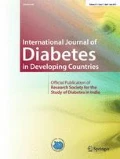Abstract
Corticosteroids, calcineurin inhibitors, and mTOR inhibitors are often used as an immunosuppressant in patients after solid-organ transplant. These agents can lead to significant hyperglycemia which is called “New onset of diabetes after transplantation (NODAT)”. Tight-glycemic control in patients with NODAT not only reduces the risk of post-transplant infection and graft failure but also reduces the long-term morbidity and mortality. Management of patients with NODAT is complicated because changes in doses of immunosuppressant can lead to change in glycemic status. Here, we present a series of cases involving successful management of hyperglycemia among outpatient department (OPD) patients with NODAT using a novel algorithm which negates the glycemic effects of corticosteroids and calcineurin inhibitors. We have also described the basic components of the algorithm which can be useful for physicians who deal with NODAT.




Similar content being viewed by others
References
Davidson JA, Wilkinson A, International expert panel on new-onset diabetes after transplantation. New-onset diabetes after transplantation 2003 International Consensus Guidelines: an endocrinologist’s view. Diabetes Care [Internet]. 2004 Mar 1 [cited 2018 Jan 2];27(3):805–12. Available from: http://www.ncbi.nlm.nih.gov/pubmed/14988309
Montero N, Pascual J. Immunosuppression and post-transplant hyperglycemia. Curr Diabetes Rev [Internet]. 2015 [cited 2018 Jan 2];11(3):144–54. Available from: http://www.ncbi.nlm.nih.gov/pubmed/25824238
Lakhani O, Kumar S. Novel insulin algorithm for management of hyperglycemia in hospitalized patients with new onset of diabetes after transplant (NODAT): a pilot study : novel treatment for diabetes (posters). In: Endocrine Society’s 98th annual meeting and expo [internet]. Boston; 2016 [cited 2018 Jan 5]. Available from: https://doi.org/10.1210/endo-meetings.2016.DGM.22.FRI-692
Sharif A, Baboolal K. Complications associated with new-onset diabetes after kidney transplantation. Nat Rev Nephrol [Internet]. 2011 Nov 15 [cited 2018 Jan 2];8(1):34–42. Available from: http://www.ncbi.nlm.nih.gov/pubmed/22083141
Rangel EB. Tacrolimus in pancreas transplant: a focus on toxicity, diabetogenic effect and drug–drug interactions. Expert Opin Drug Metab Toxicol [Internet]. 2014 Nov 26 [cited 2018 Jan 2];10(11):1585–605. Available from: http://www.ncbi.nlm.nih.gov/pubmed/25255841
Lakhani O, Kumar S, Tripathi S, Desai M, Seth C. Comparison of two protocols in the management of glucocorticoid-induced hyperglycemia among hospitalized patients. Indian J Endocrinol Metab [Internet]. 2017 [cited 2018 May 4];21(6):836. Available from: http://www.ncbi.nlm.nih.gov/pubmed/29285445
Lakhani OJ, Patel S. Successful management of a glucocorticoid-induced hyperglycemia in hospitalized patient with use of novel protocol. Int J Diabetes Dev Ctries [Internet] 2018 Jun 2 [cited 2018 Jun 3];1–5. Available from: https://doi.org/10.1007/s13410-018-0649-7
Kasiske BL, Zeier MG, Chapman JR, Craig JC, Ekberg H, Garvey CA, et al. KDIGO clinical practice guideline for the care of kidney transplant recipients: a summary. 2009 [cited 2018 Jul 9]; Available from: http://www.kidney-international.org.
Davies MJ, Alessio DAD, Fradkin J, Kernan WN, Mathieu C. Management of hyperglycaemia in type 2 diabetes , 2018. A consensus report by the American Diabetes Association ( ADA ) and the European Association for the Study of Diabetes ( EASD ). Diabetologia [Internet]. 2018; Available from: https://doi.org/10.1007/s00125-018-4729-5
Shivaswamy V, Boerner B, Larsen J. Post-transplant diabetes mellitus: causes, treatment, and impact on outcomes. Endocr Rev [Internet]. 2016 Feb [cited 2018 Jan 5];37(1):37–61. Available from: http://www.ncbi.nlm.nih.gov/pubmed/26650437
Author information
Authors and Affiliations
Corresponding author
Ethics declarations
Conflict of interest
The authors declare that they have no conflict of interest.
Ethical approval
All procedures performed in studies involving human participants were in accordance with the ethical standards of the institutional and/or national research committee and with the 1964 Helsinki declaration and its later amendments or comparable ethical standards.
Informed consent
Informed consent was obtained from all individual participants included in the study.
Additional information
Publisher’s note
Springer Nature remains neutral with regard to jurisdictional claims in published maps and institutional affiliations.
Rights and permissions
About this article
Cite this article
Lakhani, O.J. Management of new onset diabetes after transplantation (NODAT) with use of novel algorithm. Int J Diabetes Dev Ctries 39, 768–773 (2019). https://doi.org/10.1007/s13410-019-00741-2
Received:
Accepted:
Published:
Issue Date:
DOI: https://doi.org/10.1007/s13410-019-00741-2




